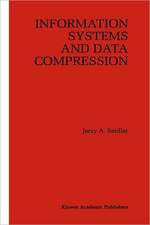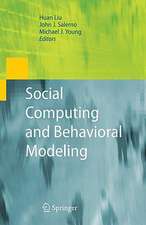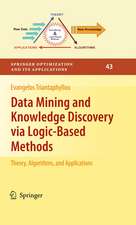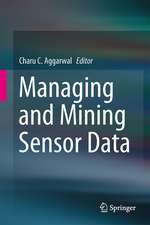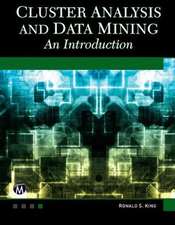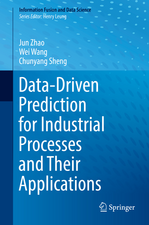Mining Sequential Patterns from Large Data Sets: Advances in Database Systems, cartea 28
Autor Wei Wang, Jiong Yangen Limba Engleză Hardback – 28 feb 2005
| Toate formatele și edițiile | Preț | Express |
|---|---|---|
| Paperback (1) | 639.72 lei 6-8 săpt. | |
| Springer Us – 6 dec 2010 | 639.72 lei 6-8 săpt. | |
| Hardback (1) | 646.30 lei 6-8 săpt. | |
| Springer Us – 28 feb 2005 | 646.30 lei 6-8 săpt. |
Din seria Advances in Database Systems
- 20%
 Preț: 994.08 lei
Preț: 994.08 lei - 20%
 Preț: 986.66 lei
Preț: 986.66 lei - 20%
 Preț: 1269.78 lei
Preț: 1269.78 lei - 20%
 Preț: 986.99 lei
Preț: 986.99 lei - 20%
 Preț: 984.04 lei
Preț: 984.04 lei - 20%
 Preț: 995.09 lei
Preț: 995.09 lei - 18%
 Preț: 947.98 lei
Preț: 947.98 lei - 20%
 Preț: 990.62 lei
Preț: 990.62 lei - 20%
 Preț: 985.68 lei
Preț: 985.68 lei - 20%
 Preț: 1279.71 lei
Preț: 1279.71 lei - 20%
 Preț: 997.25 lei
Preț: 997.25 lei - 20%
 Preț: 981.57 lei
Preț: 981.57 lei - 20%
 Preț: 644.98 lei
Preț: 644.98 lei - 20%
 Preț: 984.70 lei
Preț: 984.70 lei - 20%
 Preț: 981.06 lei
Preț: 981.06 lei - 20%
 Preț: 980.07 lei
Preț: 980.07 lei - 20%
 Preț: 1260.69 lei
Preț: 1260.69 lei - 20%
 Preț: 994.08 lei
Preț: 994.08 lei - 20%
 Preț: 991.14 lei
Preț: 991.14 lei - 20%
 Preț: 1282.83 lei
Preț: 1282.83 lei - 20%
 Preț: 649.09 lei
Preț: 649.09 lei - 20%
 Preț: 649.60 lei
Preț: 649.60 lei - 18%
 Preț: 943.25 lei
Preț: 943.25 lei - 20%
 Preț: 646.30 lei
Preț: 646.30 lei - 20%
 Preț: 993.24 lei
Preț: 993.24 lei
Preț: 646.30 lei
Preț vechi: 807.87 lei
-20% Nou
Puncte Express: 969
Preț estimativ în valută:
123.71€ • 134.42$ • 103.98£
123.71€ • 134.42$ • 103.98£
Carte tipărită la comandă
Livrare economică 22 aprilie-06 mai
Preluare comenzi: 021 569.72.76
Specificații
ISBN-13: 9780387242460
ISBN-10: 0387242465
Pagini: 163
Ilustrații: XV, 163 p.
Dimensiuni: 155 x 235 x 16 mm
Greutate: 0.44 kg
Ediția:2005
Editura: Springer Us
Colecția Springer
Seria Advances in Database Systems
Locul publicării:New York, NY, United States
ISBN-10: 0387242465
Pagini: 163
Ilustrații: XV, 163 p.
Dimensiuni: 155 x 235 x 16 mm
Greutate: 0.44 kg
Ediția:2005
Editura: Springer Us
Colecția Springer
Seria Advances in Database Systems
Locul publicării:New York, NY, United States
Public țintă
Professional/practitionerCuprins
Related Work.- Periodic Patterns.- Statistically Significant Patterns.- Approximate Patterns.- Conclusion Remark.
Textul de pe ultima copertă
The focus of Mining Sequential Patterns from Large Data Sets is on sequential pattern mining. In many applications, such as bioinformatics, web access traces, system utilization logs, etc., the data is naturally in the form of sequences. This information has been of great interest for analyzing the sequential data to find its inherent characteristics. Examples of sequential patterns include but are not limited to protein sequence motifs and web page navigation traces.
To meet the different needs of various applications, several models of sequential patterns have been proposed. This volume not only studies the mathematical definitions and application domains of these models, but also the algorithms on how to effectively and efficiently find these patterns.
Mining Sequential Patterns from Large Data Sets provides a set of tools for analyzing and understanding the nature of various sequences by identifying the specific model(s) of sequential patterns that are most suitable. This book provides an efficient algorithm for mining these patterns.
Mining Sequential Patterns from Large Data Sets is designed for a professional audience of researchers and practitioners in industry and also suitable for graduate-level students in computer science.
To meet the different needs of various applications, several models of sequential patterns have been proposed. This volume not only studies the mathematical definitions and application domains of these models, but also the algorithms on how to effectively and efficiently find these patterns.
Mining Sequential Patterns from Large Data Sets provides a set of tools for analyzing and understanding the nature of various sequences by identifying the specific model(s) of sequential patterns that are most suitable. This book provides an efficient algorithm for mining these patterns.
Mining Sequential Patterns from Large Data Sets is designed for a professional audience of researchers and practitioners in industry and also suitable for graduate-level students in computer science.
Caracteristici
Contains unique multiple models for various sequential patterns and detailed algorithms on how to mine these patterns. Bio-informaticians not yet familiar with data mining models and algorithms will appreciate the various descriptions of models and algorithms Includes supplementary material: sn.pub/extras



